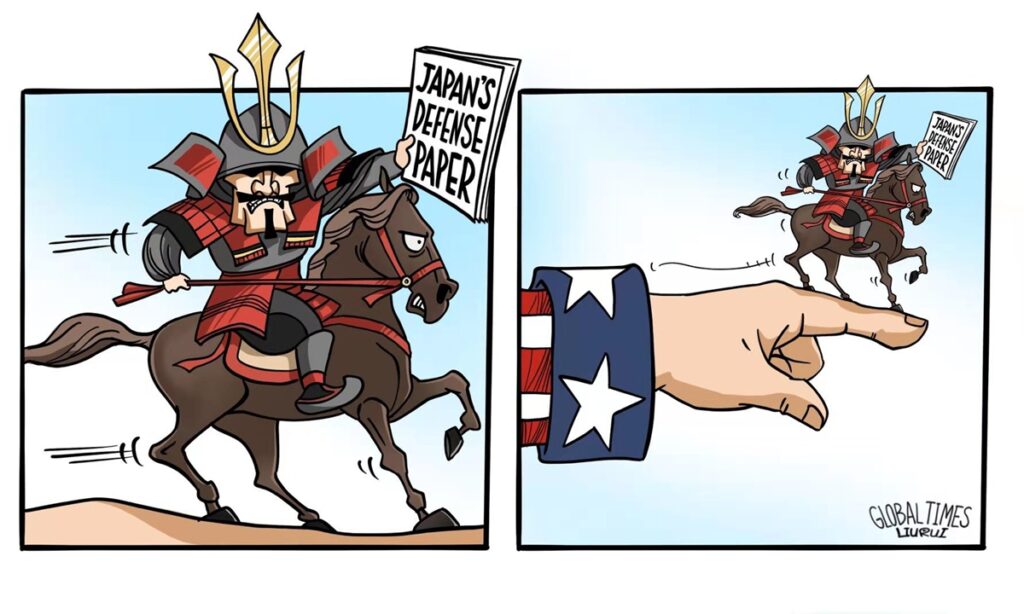As some Japanese netizens have criticized the cover of Japan’s latest defense white paper for looking “very warlike,” which features an ink painting of a warrior on a horse and is very much different from covers of previous defense papers, the Japanese office in charge of making up the paper told the Global Times on Wednesday that the cover was designed to express “guard and defend” rather than “assault.”
The official explanation failed to convince Chinese observers who believe the explanation did not match the contents of the paper. Both the “warlike” cover and the defense paper made analysts worried over the more and more explicit intentions of Tokyo to deregulate its military, and analysts question whether Japan would follow its commitment to pursue a pacifist path.
Japanese media reported that in previous years, the covers of defense white papers mostly featured pictures of weapons and members of the Japanese Self-Defense Forces, images of the Earth or Mount Fuji.
However, in order to attract the younger generations, showcase typical Japanese style to the international community and highlight the majesty of the paper, The Japanese Ministry of Defense decided to use the ink painting of a warrior on a horse by Japanese artist Yuki Nishimoto, media reported.
Nishimoto had illustrated some famous Japanese games such as Pokemon Go, and is popular among the country’s younger generation, Japanese media reported.
A ministry spokesperson said that the cover features a dynamic and profound warrior who conveys the strength of the Self-Defense Forces and Japan’s strong defense intentions.
A netizen said in Japanese that “I hate the cover of this year’s defense white paper… The previous papers are better…Isn’t it frightening that the state-controlled armed forces are depicted frivolously?”
Another pointed out that the prototype of the warrior painted on the cover bears a strong resemblance to the statue of Masashige Kusunoki, who is worshiped as one of the greatest military strategists in Japanese history. Kusunoki’s troops were defeated and he killed himself at a battle in 1336.
A netizen asked, “What era is a warrior on a horse in? It’s like going backward in history.”
Yang Bojiang, vice chief of the Institute of Japanese Studies at the Chinese Academy of Social Sciences, told the Global Times on Wednesday that the cover looks “stale” and “aggressive.”
“One has to wonder whether Japan’s future development path will continue to follow its commitment to pacifism,” Yang said.
In response to the controversy, the Japanese office in charge of making up the white paper told the Global Times on Wednesday that they were intended to express “guard and defend,” not “assault.” The office explained that the warrior on horseback is unarmed. Instead, the warrior is holding a rein, hoping that the outside world will not misinterpret this.
Hu Jiping, vice president of the China Institutes of Contemporary International Relations, told the Global Times on Wednesday that the new defense paper holds an increasingly military tone, which contradicts the office’s explanation. The cover reminds people of the “glory” of Japan’s past foreign expansion, which shows that the martial spirit is still welcomed by certain Japanese.
As Japanese nationalism has risen in recent years, “awakening” younger generation to pay more attention to national security may help the hype of the so-called China threat theory and ultimately have a negative impact on China-Japan relations, Hu warned.
The defense paper also takes up the stability of the Taiwan Straits for the first time. Chinese observers believe this exposes Tokyo’s intention to use the Taiwan question to authorize the Japanese government to use force.
Zhu Fenglian, a spokesperson for the Taiwan Affairs Office of the State Council, said the white paper contains a series of Taiwan-related mistakes, which is another irresponsible and erroneous move.
Zhu warned Japan to deeply reflect on history, immediately correct mistakes and take concrete measures to eliminate the negative impact.
Photo: GT



